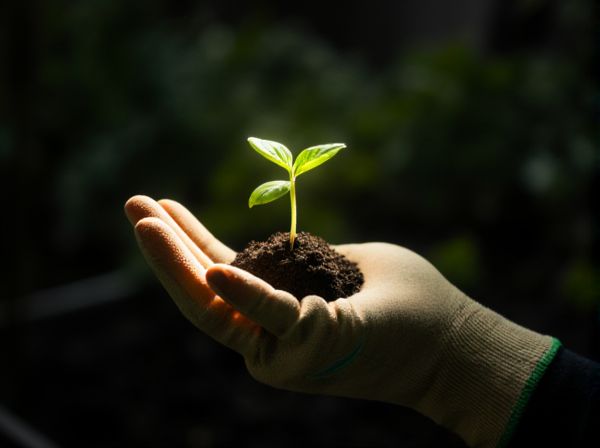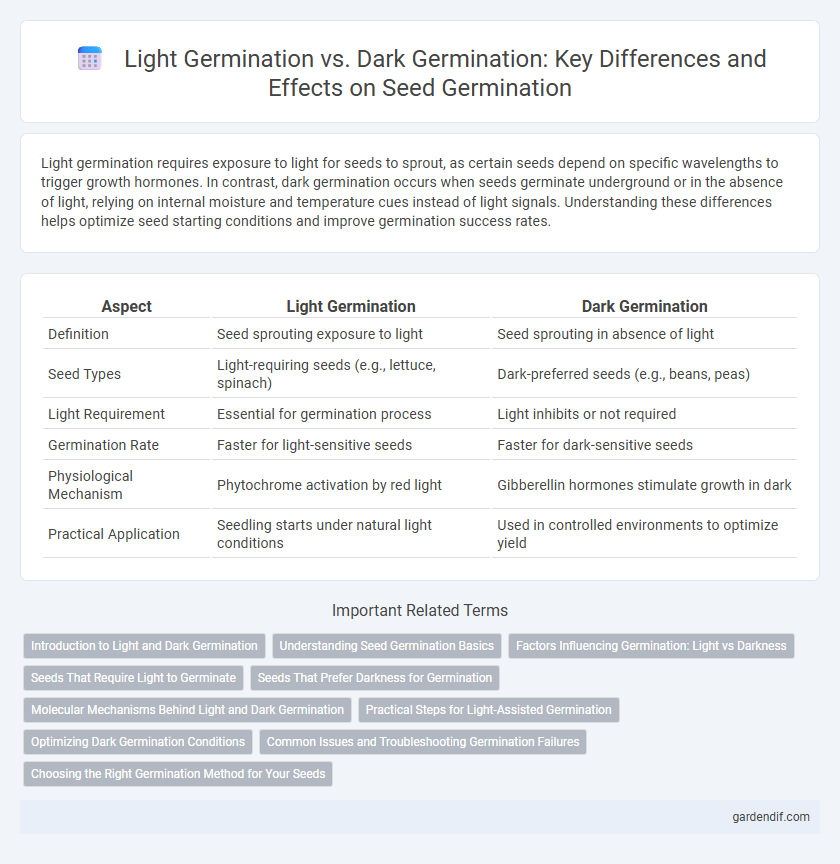
Light Germination vs Dark Germination Illustration
Light germination requires exposure to light for seeds to sprout, as certain seeds depend on specific wavelengths to trigger growth hormones. In contrast, dark germination occurs when seeds germinate underground or in the absence of light, relying on internal moisture and temperature cues instead of light signals. Understanding these differences helps optimize seed starting conditions and improve germination success rates.
Table of Comparison
| Aspect | Light Germination | Dark Germination |
|---|---|---|
| Definition | Seed sprouting exposure to light | Seed sprouting in absence of light |
| Seed Types | Light-requiring seeds (e.g., lettuce, spinach) | Dark-preferred seeds (e.g., beans, peas) |
| Light Requirement | Essential for germination process | Light inhibits or not required |
| Germination Rate | Faster for light-sensitive seeds | Faster for dark-sensitive seeds |
| Physiological Mechanism | Phytochrome activation by red light | Gibberellin hormones stimulate growth in dark |
| Practical Application | Seedling starts under natural light conditions | Used in controlled environments to optimize yield |
Introduction to Light and Dark Germination
Light germination occurs when certain seeds require exposure to light to initiate the sprouting process, benefiting from specific wavelengths that trigger photoreceptors such as phytochromes. Dark germination, in contrast, involves seeds that germinate optimally in the absence of light, relying on environmental cues like moisture and temperature instead of light signals. Understanding the distinction between light and dark germination is crucial for optimizing seed propagation and improving agricultural productivity.
Understanding Seed Germination Basics
Light germination requires seeds to be exposed to specific light wavelengths, triggering photoreceptors like phytochromes to initiate growth, whereas dark germination occurs in the absence of light, relying on internal hormonal signals such as gibberellins to promote embryo development. Understanding the role of light exposure and darkness in seed germination helps optimize conditions for seedling emergence, impacting agricultural practices and plant propagation success. Accurate knowledge of these mechanisms enables better prediction of germination rates and seed viability under varied environmental conditions.
Factors Influencing Germination: Light vs Darkness
Light germination requires exposure to specific wavelengths that trigger photoreceptors such as phytochromes, which activate enzyme systems vital for seed metabolism and growth initiation. In contrast, dark germination depends on internal hormonal balances like increased gibberellin and reduced abscisic acid, promoting embryo development without light cues. Environmental factors like light intensity, duration, and seed coat permeability critically influence the success of light or dark germination processes across different plant species.
Seeds That Require Light to Germinate
Seeds that require light to germinate, such as lettuce, petunias, and snapdragons, rely on specific wavelengths of light to trigger the biochemical processes essential for sprouting. These photoblastic seeds detect red and far-red light through phytochromes, which regulate gene expression and activate enzymes necessary for cell division and elongation. Proper exposure to light ensures higher germination rates and uniform seedling development, making light management crucial in horticultural practices for photoblastic species.
Seeds That Prefer Darkness for Germination
Seeds that prefer darkness for germination, such as lettuce, pansy, and petunia, initiate the sprouting process more effectively when shielded from light. These seeds often rely on soil coverage to create an optimal environment of low light and moisture, triggering hormonal changes that promote radicle emergence. Darkness influences the balance of phytohormones like gibberellins and abscisic acid, enhancing germination rates in these species compared to those requiring light exposure.
Molecular Mechanisms Behind Light and Dark Germination
Light germination activates photoreceptors like phytochromes and cryptochromes, triggering signal transduction pathways that regulate gene expression for seedling development through the modulation of hormones such as gibberellins and abscisic acid. In contrast, dark germination relies on the suppression of light-dependent pathways, maintaining high abscisic acid levels that inhibit premature germination and preserve seed dormancy until favorable conditions arise. These molecular mechanisms coordinate the balance between dormancy and germination by integrating environmental signals with endogenous hormonal cues to optimize plant survival and growth.
Practical Steps for Light-Assisted Germination
Light-assisted germination requires placing seeds on a moist growing medium exposed to indirect sunlight or using specialized grow lights to mimic natural daylight cycles. Maintaining consistent moisture without waterlogging the substrate and controlling temperature between 20-25degC supports optimal seed sprouting. Regular monitoring for seedling emergence ensures timely adjustments in light intensity and duration to promote robust early growth.
Optimizing Dark Germination Conditions
Optimizing dark germination conditions involves controlling temperature, moisture, and oxygen levels to promote seed sprouting without exposure to light, which can inhibit some seed types. Maintaining consistent darkness and a warm environment around 20-25degC accelerates metabolic activity and enzyme function critical for seedling development. Utilizing substrates with proper aeration and moisture retention ensures optimal conditions for dark germination success.
Common Issues and Troubleshooting Germination Failures
Seed germination can fail due to inappropriate light conditions, as some species require light to trigger sprouting while others need darkness to avoid inhibition. Common issues include insufficient light intensity for light-dependent seeds and excessive exposure for dark-preferred seeds, leading to poor or uneven germination rates. Troubleshooting involves adjusting the photoperiod, using opaque covers for dark germination, or providing full-spectrum grow lights to optimize seedling emergence and vigor.
Choosing the Right Germination Method for Your Seeds
Choosing the right germination method depends on the specific seed species, as some seeds require light to trigger germination, while others germinate best in darkness. Light germination suits seeds like lettuce and petunia, which need exposure to light to break dormancy, whereas dark germination benefits seeds such as beans and peas that naturally sprout underground. Understanding the seed's natural habitat and germination requirements ensures optimal growth and maximizes germination success rates.
Light Germination vs Dark Germination Infographic

 gardendif.com
gardendif.com